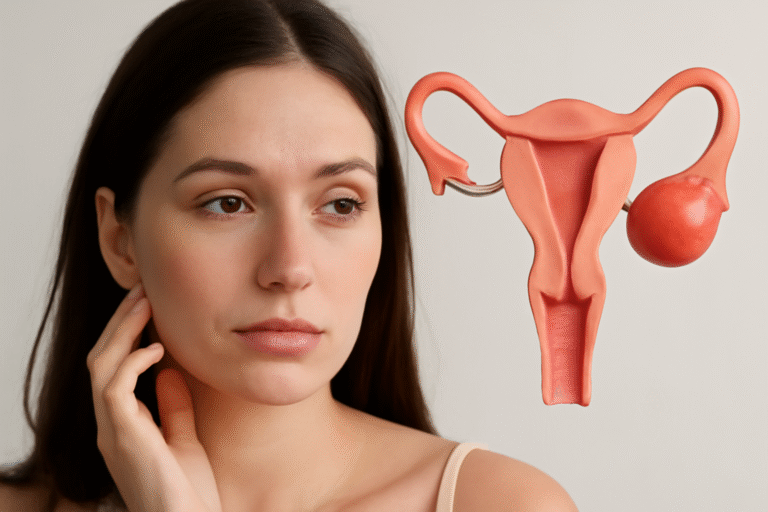What Are Anti-Müllerian Hormone Levels?
A key biomarker in reproductive health, anti-Müllerian hormone levels show the number of eggs left in a woman’s ovaries. Unlike hormones like estrogen or progesterone, which vary during the menstrual cycle, AMH is a consistent marker of ovarian reserve generated by small, developing follicles. AMH testing is a cornerstone of fertility evaluations because of its consistency; it provides information on a woman’s biological clock for conception.
Though they do not evaluate egg quality, AMH levels are frequently linked with egg count. A woman with low AMH might yet conceive naturally if her eggs are healthy; one with high AMH could have difficulties such as polycystic ovary syndrome (PCOS). Clinicians build a whole fertility profile using AMH together with other tests, including antral follicle count (AFC) and age.
AMH is used by doctors to build a whole fertility profile together with other tests, including antral follicle count (AFC) and age.
What Is Good Anti-Müllerian Hormone Levels?
Breaking Down Anti-Müllerian Hormone Levels Ranges
AMH levels are expressed as nanograms per millilitre (ng/mL) or picomoles per litre (pmol/L). Here is a thorough analysis of the significance of the figures:
- High AMH (>4.0 ng/mL): Often connected to PCOS, where an overabundance of tiny follicles causes erratic ovulation.
- Normal AMH (1.5–4.0 ng/mL): Indicates a healthy ovarian reserve, ideal for natural conception or IVF.
- Low AMH (<1.5 ng/mL): indicates reduced ovarian reserve, which is typical in women over 35 or those with premature ovarian insufficiency (POI).
- Very Low AMH levels (less than 0.5 ng/mL) are associated with a poor response to IVF stimulation and an increased risk of early menopause.
Age-Specific AMH Benchmarks
Though the pace differs greatly, AMH levels naturally drop with age. To give an example:
- Levels peak about 4.0 ng/mL for ages 20–25.
- Average levels fall to 2.0–3.0 ng/mL for ages 30–35.
- Often below 1.0 ng/mL, levels indicate a significant drop in egg count for ages 40+
Depending on age, a “good” AMH level changes. While a 38-year-old with the same level might experience faster fertility problems, a 28-year-old with 2.5 ng/mL is within the acceptable range.
How Anti-Müllerian Hormone Levels Work and Why It’s Reliable
The AMH Blood Test: Simple, Fast, and Informative
AMH testing usually consists of a simple blood draw done on any day of the menstrual cycle. Results are accessible in 24 to 48 hours, which makes it a useful tool for fertility clinics. Many providers increase the precision of ovarian reserve evaluations by combining AMH with transvaginal ultrasound to count antral follicles (AFC).
Limitations and Misconceptions
Although AMH is quite dependable, it has some drawbacks:
- No Insight into Egg Quality: A normal AMH does not ensure good eggs.
- Temporary Fluctuations: Hormonal birth control can lower AMH by as much as 30%; vitamin D deficiency might distort outcomes.
- Ethnic Variations: Research indicates AMH levels differ somewhat among ethnic groups, although the clinical relevance is still under discussion.
Low Anti-Müllerian Hormone Levels: Causes, Emotional Impact, and Pathways to Parenthood
Why Do Anti-Müllerian Hormone Levels Drop?
Several elements cause low AMH:
- Age-Related Decline: Natural drop in follicle count post-35.
- Premature Ovarian Insufficiency (POI): Affects 1% of women under 40, usually because of genetic or autoimmune diseases.
- Medical Treatments: Ovarian surgery, radiation, or chemotherapy can harm follicles.
- Lifestyle Factors: Smoking and persistent stress hasten ovarian ageing.
Fertility Options for Low AMH
A low AMH anti-Müllerian hormone level is not a dead end. Choices are:
- Aggressive IVF Protocols: More egg recruitment comes from higher doses of stimulation drugs.
- Egg Donation: Using donor eggs for better success rates.
- Natural Cycle IVF: A gentler option for women with extremely low reserves is natural cycle IVF.
- Ovarian PRP or DHEA: Experimental treatments showing promise in small studies
High AMH Levels: The Double-Edged Sword of PCOS
PCOS and AMH: A Complex Relationship
An excess of tiny ovarian follicles causes women with PCOS to frequently have AMH levels over 4.0 ng/mL. High AMH in PCOS, on the other hand, is linked to hormonal abnormalities that cause irregular ovulation and problems getting pregnant naturally. A study published in The Journal of Clinical Endocrinology & Metabolism (2023) found that women with PCOS have AMH levels 2–3 times greater than those without the condition.
Managing High AMH in Fertility Treatments
High AMH raises the likelihood of ovarian hyperstimulation syndrome (OHSS) during IVF. Clinics reduce this by:
- Using lower doses of stimulation drugs.
- Incorporating GnRH antagonist protocols.
- Freezing all embryos to avoid pregnancy exacerbating OHSS.
Should Every Woman Get Tested?
The Case for Routine AMH Screening
Proponents of AMH testing say it enables women to decide wisely on early family planning or egg freezing. A 25-year-old with low AMH, for instance, might give fertility preservation top priority; someone with high AMH could handle PCOS symptoms aggressively.
The Risks of Overreliance on AMH
Critics warn that AMH by itself cannot forecast fertility. Emphasizing that egg quality and partner fertility are equally important, a 2023 study in Human Reproduction revealed that 40% of women with low AMH became pregnant naturally within a year.
Emphasizing that egg quality and partner fertility are equally vital, a 2023 study in Human Reproduction revealed that 40% of women with low AMH conceived naturally within a year.
Also Learn: Learn About Gestational Surrogacy
AMH’s Role in Predicting Menopause
Can AMH Forecast Menopause Timing?
University of Copenhagen (2023) ground-breaking studies found that AMH levels can forecast menopause within a 4-year range. For example, women with AMH <0.2 ng/mL at age 45 are probably going to enter menopause by age 50. This information helps to control long-term health concerns like osteoporosis and family planning.
General Health and AMH
Low AMH is connected to more post-menopausal bone density loss and cardiovascular disease. Women with reduced reserves are advised to have regular monitoring and preventive care, including weight-bearing exercise and calcium supplements.
Women with reduced reserves are advised to have regular monitoring and preventive care, including calcium supplements and weight-bearing exercise.
Boosting Anti-Müllerian Hormone Levels
Can Lifestyle Changes Make a Difference?
Although mostly hereditary, AMH is being shown by new research to be
- Vitamin D Optimization: Fixing shortages could help stabilize the AMH drop.
- DHEA Supplementation: Small studies have indicated that women with POI may see slight increases in AMH.
- Smoking Cessation: Smoking speeds ovarian ageing, therefore lowering AMH levels.
The Truth About “AMH-Boosting” Products
Watch out for unregulated goods such as herbal teas or “ovarian rejuvenation” therapies. A 2022 Fertility Research and Practice study revealed no strong proof to back up these assertions. Concentrate instead on tried-and-true techniques such as donor eggs or IVF.
Concentrate instead on tried-and-true techniques such as IVF or donor eggs.
Key Takeaways: Navigating Your AMH Journey with Confidence
- AMH is a Tool, Not a Prognosis: Low levels don’t equate to infertility—egg quality and overall health matter.
- Age + AMH = Personalized Planning: Use your results to guide egg freezing, IVF, or lifestyle adjustments.
- Advocate for Comprehensive Care: Pair AMH testing with AFC, FSH, and partner semen analysis for a full picture.
Final Note: AMH anti-Müllerian hormone levels offer a strong window into ovarian health, but they are only one puzzle component. Work with a reproductive endocrinologist to analyze your findings and investigate routes suited to your biology.





[…] Also Read: Learn About AMH Level […]
[…] Also Read: Learn About AMH level […]
[…] Also read: Anti-Müllerian Hormone Levels: What You Need to Know […]